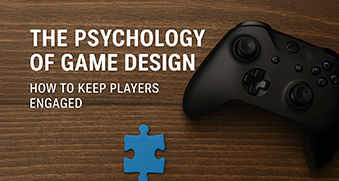The Psychology of Game Design: How to Keep Players Engaged
Understanding the psychology of gaming is the key to designing games that people can’t put down. By tapping into what motivates players, balancing rewards, keeping the challenge just right, telling emotional stories, offering real choices, and fostering social connections, you can create engaged games that stand out in the world of game design psychology.


Introduction
Ever wonder why some games just seem to pull you in and keep you playing for hours? It’s not always about flashy graphics or cool mechanics—it’s the game psychology at play. When game designers really get inside players’ heads, they create experiences that are hard to put down. In this article, let’s dive into the game design psychology that makes engaged games so compelling and explore how you can use these insights to make your own games unforgettable.
Understanding What Motivates Players
To create games that people love, you first need to understand what drives them to play in the first place.
Self-Determination Theory (SDT)
At its heart, Self-Determination Theory says we’re all motivated by three things: feeling in control (autonomy), getting good at something (competence), and connecting with others (relatedness). In the world of game design psychology, this means giving players choices, helping them master skills, and letting them team up or compete with friends.
Bartle’s Player Types
Not everyone plays games for the same reason. Some want to win and collect achievements (Achievers), others love exploring every corner (Explorers), some just want to chat and socialize (Socializers), and a few thrive on competition (Killers). Understanding these types is a big part of designing engaged games that appeal to everyone.
The Art of Rewards: Instant Gratification vs. Long-Term Goals
Rewards are the secret sauce in game psychology. Get them right, and players will keep coming back for more.
Instant Gratification: Little rewards—like leveling up, unlocking new items, or hearing that satisfying “ding!â€â€”give players a quick hit of happiness. These small wins keep the excitement alive and make it hard to stop playing.
Long-term Satisfaction: Bigger rewards—like finishing a tough quest or earning a rare trophy—give players something to strive for. These long-term goals keep them invested and coming back day after day.
Risk and Reward Balance: Games that make you weigh risks and rewards are extra exciting. Whether it’s betting in-game currency or taking on a tough boss, the right balance keeps players on their toes and makes every decision count.
Flow and Challenge: The Perfect Balance: Have you ever lost track of time playing a game? That’s “flow,†and it’s a big part of the psychology of gaming.
Gradual Difficulty: Starting easy and slowly ramping up the challenge helps players build confidence and stay in the zone. No one likes feeling overwhelmed or bored, so getting this balance right is key.
Dynamic Difficulty: Some games adjust the challenge on the fly, making sure you’re always just challenged enough. This keeps engaged games feeling fresh and fair, no matter your skill level.
Emotional Engagement and Storytelling
Great game design psychology knows that emotions are what make games truly memorable.
Narrative and Empathy: A good story with relatable characters can make players care deeply about what happens next. When you feel for the characters, you’re more likely to stick around to see how things turn out.
Music and Atmosphere: The right music and sound effects can set the mood and pull you even deeper into the game world. A haunting soundtrack or a tense atmosphere can turn a good game into an unforgettable one.
Choice and Autonomy: Player Agency: Players love feeling in control—it’s a big part of game psychology.
Branching Narratives: Games that let you make choices and shape the story give you a real sense of ownership. When your decisions matter, you’re more likely to keep playing to see all the different outcomes.
Open-World Exploration: Open-world games let you go wherever you want and discover things at your own pace. This freedom is super satisfying and keeps players coming back for more adventures.
Social Connectivity: Playing with Others
Humans are social creatures, and game design psychology takes full advantage of this. Multiplayer modes, leaderboards, and team challenges make games more fun and engaging by letting you play with—or against—others.
Using Feedback to Improve Game Design of Psychology
Listening to what players have to say is one of the best ways to make engaged games even better. Regular updates, responding to feedback, and involving the community help games grow and stay fresh over time.
Conclusion
Understanding the psychology of gaming is the key to designing games that people can’t put down. By tapping into what motivates players, balancing rewards, keeping the challenge just right, telling emotional stories, offering real choices, and fostering social connections, you can create engaged games that stand out in the world of game design psychology. Ready to make your next game unforgettable? Start thinking like a player!


CATEGORIES
- MBA Program
- Data Science and Analytics
- Cloud Computing
- Data Analytics and Business Intelligence
- AI and Digital Systems
- Cyber Security and Digital Forensics
- Business Analytics & Intelligence
- Banking & Financial Services
- International Business
- Digital Marketing
- Research Paper
- Media & Entertainment
- Media Management
- Journalism and Media Production
- Media & Information Technology
- Visual Communication
- Game Development
- Sound Engineering
- Game Art & Design
- Photography
- Film Making
- Animation & VFX
Are you aspiring to become a proficient Game Art & Design professional?
Look no further; we are committed to nurturing the potential of young minds. Are you ready to enhance your skills?


